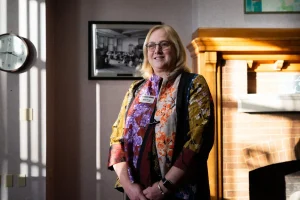Student Association talks active shooter training and elects a new Chief of Justice
September 19, 2019
On Wednesday, Sept. 18, University detective Chris Schuster was invited by the Student Association to conduct a portion of an active shooter civilian response program known as ALICE. ALICE stands for “Alert, Lockdown, Inform, Counter, Evacuate.” It’s a new and improved model that claims to be more reassuring than the previous stationary method of staying away from windows and doors, hidden in a room with the lights off.
For context, officer Schuster began his presentation with a recent viral public service announcement from the anti-violence non-profit group “Sandy Hook Promise.” Then he described that the best–case scenario, if any, during an on–campus shooting is a police response time of 10 minutes, a standard that officer Schuster says is possible because of UWL’s “geographically small footprint.”
In order to accomplish this time frame, a 911 call must be made within one minute, in a manner that is as direct as it is efficient. Once this is accomplished, the dispatcher can send police officers out in three minutes’ time. Schuster said it’s very important to “try and get your information out first,” such as the area where the emergency is happening, followed by a description of the individual during the call.
Following the report to dispatch, the officer response should be followed by a one–minute entry into the area. Locating the aggressor takes another minute, which Schuster calls a “generous” amount of time, as some situations call for different strategies. Within those 10 minutes, however, the statistics Schuster presented indicate that the amount of time for a response 40 shots are already fired, 20 being injuries and another 20 fatalities.
“We can’t just rely on law enforcement to help with this situation, we need you all to be somewhat versed in how to react to these situations,” said Schuster. Schuster recommended everyone in the chamber to keep their cell phones on them at all times, as these situations have been happening often.
Some examples of what not to do, according to Schuster, where the situations which allowed the Virginia Tech and Columbine shootings to be so deadly. Schuster recollected on a circumstance where response time could have been more efficient during the Virginia Tech shootings.
Before the attack on Norris Hall, the assailant chained all the entry points. A student was running late for her class and saw these doors locked; but instead of asking why the popular hall was locked in the middle of the day, she decided to climb through a window in order to get to her class on time.
“Don’t do that,” said Schuster. “If you see something, say something. I hope that you would think enough to call facilities, call the police department, and ask why this building is closed during a school day.”
During Columbine, the sit and hide practice ended up leaving many students vulnerable when other options could have secured their safety. Columbine’s library was scattered with students hiding under tables and behind bookshelves, leaving them as open targets. The shooters entered the library and executed students one by one.
Schuster says that sitting and hiding was what “people knew to do” at the time.” Using a diagram of the library, Schuster explained the many exit points the students had, which would have been a more viable option instead of sitting and waiting for help.
The traditional lockdown was developed in the 1980s in the Los Angeles area, during a time where the city was experiencing an excessive number of drive-by shootings. Turning off lights, staying away from windows and locking doors are actions appropriate for an exterior threat. For an interior threat, hiding under desks and locking doors “does nothing if there is an active threat running around inside your space,” said Schuster.
The “Alert” in ALICE could be a gunshot or a voice on the PA system warning of an imminent threat. Communication should be direct and precise during this time, and the use of codes should be avoided. Any type of threat is a sound reason to alert authorities. “We would rather respond to something that’s nothing than not respond to something that could gain traction,” said Schuster.
If evacuating is not a safe option, ALICE recommends a “lock-down.” Schuster demonstrated this through pictures of past year’s active training shooting, showing desk, and chairs packed over entry points. During this time if the barricades are penetrated, Schuster recommends “Prepare to counter if needed. Remain aware of the surroundings and get to any safe locations and barricade to ensure your safety.”
As a last resort, countering the assailant could throw off their “ooda-loop.” Ooda-loop is the cycle meaning “observe-orient-decide-act,” a method developed by Air Force Colonel John Boyd. The idea is to do whatever is in your power to throw the shooter off; whether that’s throwing water bottles, coffee or a simple distraction, the shooter would not be ready for an immediate and random counter.
Schuster concluded his time with a round of applause from the senate. This most likely will not be the last the University hears from the detective; as more interactive sessions are to be planned during some weekend this month. During the discussion portion, Sen. Neader mentioned how he would have liked to have known this information upon entering college, suggesting that a portion of ALICE training be applied to student orientation.
After the presentation, the Senate voted in a new Chief of Justice, Ben Ames. Ames is a non-traditional student here at UWL with experience on last year’s student court as their associated justice, having been recommended by last year’s senate Chief Justice Robert Gorde. Ames talked about his experience, his decision on going back to school, and the importance of starting “bottom to top” with having younger representation for student justices who can practice for the court throughout their story.






